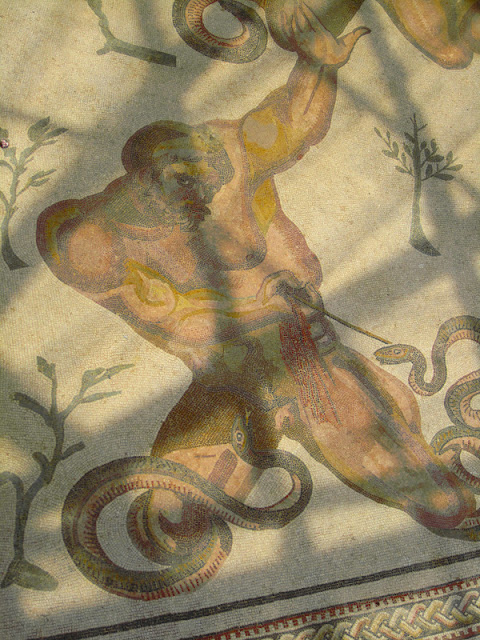This trip back to Central Sicily was great not only to see Enna and the Good Friday procession, but also to come back and see A) The Greek/Roman/Carthaginian city of Morgantina/Serra Orlando (3rd and 4th Century BC), which, for those of you following the blog was FOG bound the
last time I was here with SYA back in 2010 B) to see the repatriated "Venus of Morgantina and C) to see the mosaics of Villa Romana del Casale in the town of Piazza Armerina, which was closed to the public when I last visited. It felt like I was tying up loose ends to get to visit these sites!!
 |
| You see a grid plan, you know it has been under Roman control! |
|
 |
| Up here in the "residential" area we are looking down on the agora, or public area. That excavated square area on the left is the "macellum" which was where there were stores. The excavated area on the right is the "area sacra." |
 |
| The lower area in this pictures is the "prytaneion", which if I am reading my Italian correctly is where the officials hosted guests. The upper area is the "casa del saluto", not a hospital but a public bath. |
 |
| You can see why they chose this site.....high on a ridge with a beautiful view. |
 |
| Now, down in the agora area, we are looking up the "Platea A", which was the main paved street leading to the residential areas. |
 |
| The East Stoa where there were offices for the politicians and a general "city hall" |
 |
| Most of the archeological finds of the Morgantina site are housed at this small museum in the town of Aidone. |
 |
| The museum is quite proud of the fact that inside it has the "Venus of Morgantina" |
 |
| As with every cultural site in Italy, the sponsors are always listed, but here you'll notice that one of them is the Getty Museum in Los Angeles. Why? |
 |
| The abbreviated story is that the Getty Museum purchased the Venus through traditional art channels, but because it was originally taken by tomb raiders, it was repatriated back to Italy. It came to this location because the marble is from a formation of rock that is found in this part of Sicily, but whether or not it came from the Morgantina site cannot be determined for sure. Regardless, she's here in Aidone, in this small museum in Central Sicily, whereas she once lived the high life in Los Angeles. |
 |
| The somewhat realistic drapery indicates it probably is late classical...right at its tail end as it begins the morph into the amazing realism that was achieved in the Hellenistic age. |
 |
| THIS was amazing!! When the excavators were doing the official excavation, they found this modern Italian 100 Lire coin from 1978, which helps date the time that there was "tomb raiding". |
 |
| Last stop....Villa Romana del Casale, or more commonly known as Piazza Armerina. |
 |
| This complex was probably the residence of a series of wealthy 3rd/4th century AD Roman import/exporters. Central Italy, being right in the middle of the Mediterranean was the crossroads of trade from Africa to Europe. The owners of this huge villa profited from that trade and over the course of time continually added to the structures, thereby giving it's "organic" layout. |
 |
| The excavations are ongoing, but everyone comes here to see the mosaics. I would guess that less than 20% of the mosaics are open to the public. Here's the triclinium, with its crappy enclosure and roof. |
 |
| The triclinium was the dining area. You can see the main part of the eating area with the three "private" areas. |
 |
| What was entertainment as they ate? The floors of course! |
 |
| The most "famous" mosaic at Piazza Armerina is the one of the girls in the bikini's. The room was probably some kind of changing/locker room Up in the corner, you'll see a part that was ripped, turns out underneath is another mosaic when the room had a different purpose. |
 |
| The theory is that the young girls were in a pageant or sporting contest. The clothed woman on the left was the judge, or their caretaker. |
 |
| These animals are not found on the European continent, adding to the evidence that there was lots of trade from Africa coming through this area. |
|
 |
| Why are the animals in this picture and the one above ALL looking in the same direction? |
|
 |
| They are ALL being enchanted by this musician (I forget his name). These mosaics were from the "music room." Makes sense |
 |
| In the hallway that leads to the triclinium is the "hallway of the hunt" |
 |
| More exotic animals! |
 |
| You'll see the hunters, but looking closely at the robe of the hunter on the left, you'll see a sign that was co-opted in modern times. |
 |
| I particularly like this one where a tiger has found a mirror and is fascinated by its reflection! |



































































